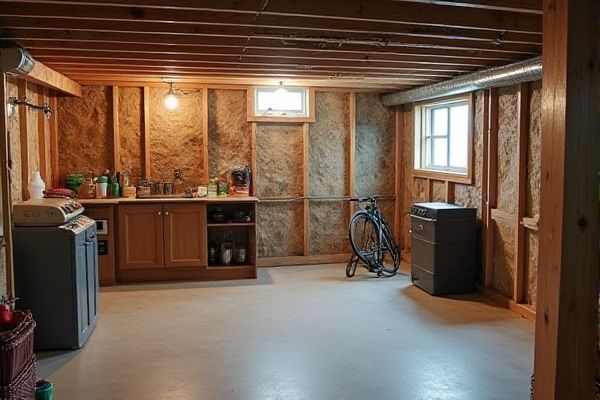
Crawl space storage offers a compact area ideal for seasonal items and tools but may face humidity and accessibility challenges compared to basement storage, which provides a larger, more climate-controlled environment suitable for a wider range of belongings. Explore the rest of this article to understand which storage option best fits Your home's needs.
Table of Comparison
| Feature | Crawl Space Storage | Basement Storage |
|---|---|---|
| Space Size | Limited, low clearance (typically 18-24 inches) | Large, high clearance |
| Accessibility | Restricted, often requires crawling or stooping | Easy access with stairs and open floor |
| Moisture Control | High risk of dampness and mold without vapor barriers | Better moisture control with proper insulation and sump pumps |
| Temperature Stability | Prone to temperature fluctuations | Generally stable, cooler environment |
| Pest Exposure | Higher risk of pests and rodents | Lower risk if sealed properly |
| Cost of Preparation | Lower initial cost, but may need moisture and pest control | Higher cost due to finishing and waterproofing |
| Storage Type Suitability | Best for non-sensitive, bulky items | Suitable for a wide range, including sensitive items |
| Resale Value Impact | Minimal improvement to home value | Can significantly increase home value |
Crawl Space vs Basement Storage: Key Differences
Crawl space storage differs from basement storage primarily in terms of height, ventilation, and moisture control, with crawl spaces typically offering less headroom and higher vulnerability to dampness and pests. Basements provide more spacious, climate-controlled environments ideal for storing larger items and sensitive belongings, reducing the risk of mold and water damage often found in crawl spaces. Understanding these differences will help you choose the best storage solution tailored to your home's structure and storage needs.
Space Utilization: Maximizing Storage Potential
Crawl space storage offers limited height but can be optimized with low-profile containers to maximize storage potential in narrow areas, making it ideal for seasonal or infrequently used items. Basement storage provides larger, more accessible space with higher ceilings, allowing for flexible organization systems such as shelves and cabinets to efficiently store a wider range of belongings. Your choice depends on the type and volume of items you need to store, ensuring optimal space utilization tailored to your home's design.
Accessibility: Ease of Use and Entry
Basement storage offers superior accessibility due to typically larger entryways and level floors, allowing for easier movement of bulky items and equipment. Crawl space storage often involves low, confined areas accessible through small hatches, limiting ease of use and requiring crawling or crouching to reach stored goods. For frequent access and convenience, basements provide a more user-friendly storage environment compared to the restricted access of crawl spaces.
Climate Control: Moisture and Temperature Concerns
Basement storage offers better climate control due to typically lower humidity levels and more consistent temperatures, reducing the risk of mold and mildew. Crawl space storage often faces higher moisture levels and temperature fluctuations, increasing the likelihood of damage to stored items unless proper vapor barriers and insulation are installed. Effective climate control in basements helps preserve sensitive materials, whereas crawl spaces require enhanced moisture management solutions to remain viable storage areas.
Safety and Security: Protecting Stored Items
Crawl space storage often poses higher risks to the safety and security of stored items due to limited ventilation, higher moisture levels, and potential pest infestations that can damage belongings. Basement storage typically offers a more controlled environment with better structural protection from weather elements and easier installation of security measures such as locks and alarms. To safeguard your stored items effectively, basement storage is generally the safer and more secure option.
Cost Comparison: Storage Solutions and Upgrades
Crawl space storage typically costs less upfront than basement storage due to smaller space requirements and simpler renovation needs, with basic upgrades averaging $1,000 to $3,000. Basement storage offers greater capacity and flexibility but involves higher expenses, often ranging from $5,000 to $15,000 for insulation, moisture control, and custom shelving. Long-term costs for crawl spaces may increase if moisture mitigation is neglected, whereas basement upgrades generally include integrated waterproofing systems to protect stored items and maintain value.
Common Storage Items for Crawl Spaces
Crawl space storage commonly accommodates seasonal decorations, tools, and garden supplies due to its limited height and ventilation. Items stored here should be moisture-resistant or placed in waterproof containers to prevent mold and mildew damage. Unlike basements, crawl spaces are less suitable for bulky or frequently accessed items because of restricted access and lower ceilings.
Best Uses for Basement Storage
Basement storage is best used for items that require a stable, dry environment such as seasonal decorations, tools, and valuable memorabilia. Unlike crawl spaces, basements typically offer more usable square footage with easier access and better climate control for long-term preservation. This makes basements ideal for storing large or frequently accessed items while protecting them from moisture and temperature fluctuations.
Maintenance Requirements: Keeping Spaces Functional
Crawl space storage demands regular moisture control and pest prevention to keep the area dry and safe, while basement storage requires consistent monitoring for potential water leaks and mold growth. Both spaces benefit from proper insulation and ventilation to maintain a functional environment, yet basements often need more extensive waterproofing solutions. Your choice should consider the ongoing upkeep commitment to ensure these storage areas remain practical and well-preserved.
Choosing the Right Storage Option for Your Home
Crawl space storage offers a compact, moisture-prone solution ideal for storing non-sensitive items and maximizing under-floor areas, while basement storage provides a larger, more versatile environment with better climate control for valuable or frequently accessed belongings. When choosing the right storage option for your home, consider factors such as accessibility, humidity levels, and security needs to protect your possessions effectively. Your selection should align with the type of items stored and the overall condition of your home's foundation areas.
 homyna.com
homyna.com